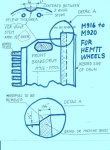I have worked on hyd systems in helicopters but this is pretty different. A "Parallel pump" is that basically 2 individual pumps in one housing? Am I correct in understanding that you can shut off/disable one of the circuits? If so, how do you go about doing this?
I agree that you should get an electric pump for raising or lowering the roof, reason why is they supply maybe 1.5 gpm and if you tried to use the 920 pump even if you just use one side of it raising and lowering something that small in dimension would be more like a space shuttle takeoff.
I almost blew coffee all over my keyboard with that one.... lol. (Might be fun to watch...once..)
You can try to restrict the flow down but it would cost you tons more trying to do that then to buy an electric pump.
Forgive my hyd design ignorance but... Can't you just flow restrict the line by using a smaller diameter fitting/hose or a control valve that is designed for a lower flow?
As for re using the winch. It is heavy, huge, and requires every bit of that 44 gpm to move at any speed. The 5 ton m816 has a similar weight rating as the 920 weighing in at over 32k and they have a standard 5 ton 20k winch on that truck and it works just fine, convert this to hydraulic and reduce the pump to a mono pump for a total of 22 gpm and be done with it.
The Ramsey 45k hyd winch (#RPH 45,000) which looks to be about the same general physical size of the 45k winch on the 920 weighs in at a back breaking 689 pounds.
The Ramsey 20k weighs 375lbs and the 30k 486 lbs. They both use 15gpm, I could not find the PSI requirements for the Ramsey winches.
From what I have been able to learn most modern winches need 3,000psi. The pump on the M920 "Only" puts out 2,350 psi.
The Warn company offers both a "Standard" pressure and a low pressure version of their winches. They also offer a short or long drum, the difference being how much cable you can keep on the drum. Since we are talking large vehicles and my personal presence is for as much cable as I can get, weights will be for the long drum version. See below:
Rating Weight PSI GPM
20k 329 3,000 20
20k low press. 322 2,200 20
30k 361 3,000 20
30k low press. 361 2,320 20
I would be interested in the weight of the 20k hyd winched used on the MV's if anybody happens to have it, also the PSI and flow output of the pump used to drive it.
Something tells me that you will not be burying this truck to its nuts in mud so it should be more than adequate especially if you are removing the winch, 5th wheel plate, tag axle etc.
Now, given all the above; The M920 basic weighs in at 30k. I'm not sure how much weight the OP is planning on by my 920 will be hauling around another 20-25k of RV on it's back for a total of about 50-55k pounds.
I can't speak for the OP but in talking to him I believe he probably understands the concept of, "When your stuck, stop digging in and start winching" so that your comment about not burying the truck is likely correct. I know I learned that lesson many years ago. I have a winch for a reason... to be used, not to look pretty. Unlike some people, I find no embarrassment in using it to make my life much easier. When stuck the sooner you turn to the winch, the easer the process will go.... usually....lol. Of course right here on SS we recently had a member that went from driving to front bumper on the ground instantly and without any warning. When that happens, you better be ready with enough winch power to haul your dinosaur out.
Even with a snatch block the 20k is only going to give you 40k of pull. That might not be enough for a truck looking at the better part of 50k static weight. Even a 30k with a block will just barely give me = the weight of the rig. And that does not include drag/suction of whatever it is stuck in.
I'm thinking that for both the OP and myself, a 30k is probably going to be the minimum. Of course if either of us finds a 20 MV winch for the right price it might find it's way onto the front of our respective RV's. I know I'll be relocating my 45k to the back of the rig.




